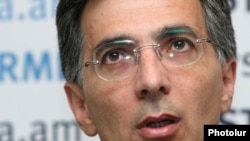Davtian likened the Armenian economy to an airplane that landed successfully after a mid-air refueling carried out in turbulent conditions.
“Our economy resembles an airplane that entered a zone of turbulence which forced its crew to switch off the autopilot system and try to get out of that zone manually,” he said. “Our plane is quite small, lacked fuel and had one of its engines out of order.”
“We have managed to pass through turbulence and I think we have reached the destination by the end of the year without big losses,” he told a year-end news conference. “And I think we have done so in a way that didn’t make the passengers worry a lot. The trouble wasn’t quite felt.”
Armenia’s GDP is on track to shrink by at least 15 percent in 2009 after more than a decade of robust growth. According to World Bank estimates, the number of Armenians living below the official poverty line rose by 90,000 to make up 28.4 percent of the population in the first half of the year. Both the bank and the Armenian government expect the economy to rebound in 2010.
Davtian’s statements clearly reflect the opinion of President Serzh Sarkisian and Prime Minister Tigran Sarkisian. President Sarkisian has repeatedly stated that his administration has spared Armenia painful socioeconomic “upheavals.”
Davtian also emphasized the fact that the government has avoided social spending cuts and managed to keep its overall expenditures close to the level envisaged by the state budget for 2009. The budget, drawn up before the economic crisis, called for 945 billion drams ($2.5 billion) in government expenditures.
Davtian said the government has spend at least 905 billion drams despite an almost 18 percent drop in its tax revenues. The government has used a large part of some $1.3 billion in anti-crisis loans obtained this year to cover the tax shortfall.




